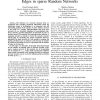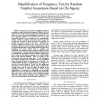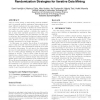113 search results - page 7 / 23 » Determining the Significance of Item Order In Randomized Pro... |
BIOCOMP
2006
13 years 9 months ago
2006
Abstract-- The inference of a network structure from experimental data providing dynamical information about the underlying system of investigation is an important and still outsta...
SIGECOM
2003
ACM
14 years 1 months ago
2003
ACM
Preference elicitation — the process of asking queries to determine parties’ preferences — is a key part of many problems in electronic commerce. For example, a shopping age...
AICT
2008
IEEE
13 years 8 months ago
2008
IEEE
This paper presents the simplified method of random test suite based on the frequency (block) test. The test is used to check the first property of random numbers which is to have ...
VLSID
2005
IEEE
14 years 1 months ago
2005
IEEE
During pseudorandom testing, a significant amount of energy and test application time is wasted for generating and for applying “useless” test vectors that do not contribute t...
KDD
2009
ACM
14 years 8 months ago
2009
ACM
There is a wide variety of data mining methods available, and it is generally useful in exploratory data analysis to use many different methods for the same dataset. This, however...



